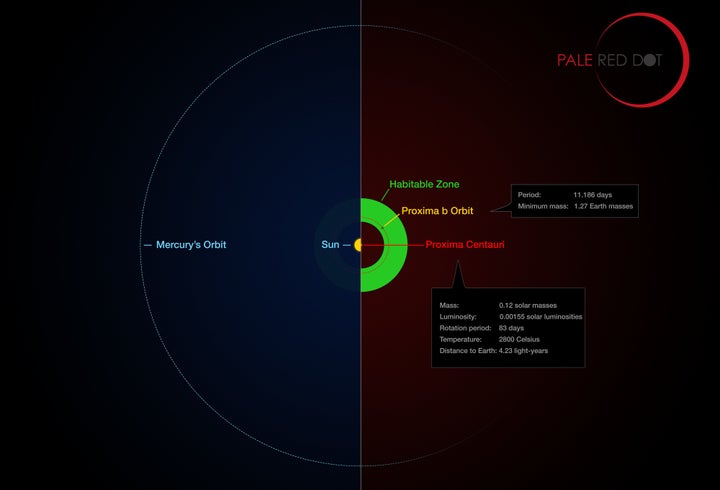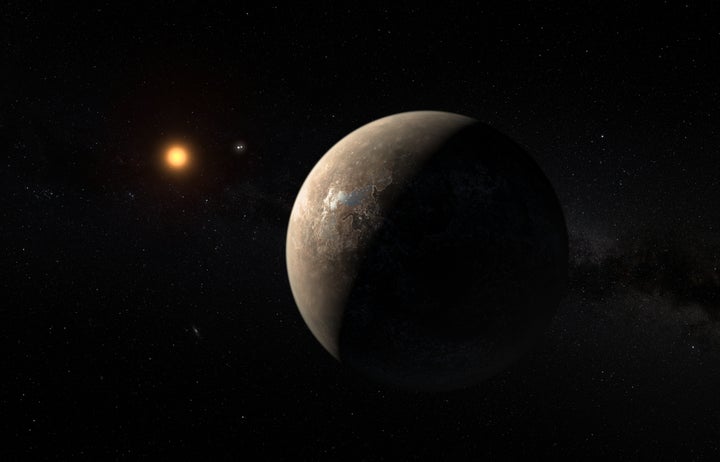An Earth-like planet that could support life has been discovered by European astronomers orbiting our nearest star Proxima Centauri.
The discovery of Proxima b is incredibly significant for the simple reason that at just four light-years from our Solar System, it is now our closest known planet that could support alien life.
The exoplanet is around 30 per cent larger than Earth, and while its orbit to Proxima Centauri is much closer than Earth’s the star is much fainter placing the planet smack bang in the middle of the long-sought ‘Habitable Zone’.

Proxima b orbits the sun every 11 days and has a temperature that, according to ESO scientists, is suitable for liquid water to exist on its surface.
Despite this it’s important to note that Proxima b’s surface will still look incredibly alien compared to the greens and blues of our own planet.

Even though the star is weaker, Proxima’s close proximity to it means that the planet will be bombarded with incredibly powerful ultraviolet and X-ray flares, meaning that if there is life, it will have needed to adapt.
Two papers have examined in depth the plausibility of life on the planet and found that liquid water is possible, however it would only be found on the sunniest regions of the planet.

Guillem Anglada-Escudé concludes: “Many exoplanets have been found and many more will be found, but searching for the closest potential Earth-analogue and succeeding has been the experience of a lifetime for all of us.”
“Many people’s stories and efforts have converged on this discovery. The result is also a tribute to all of them. The search for life on Proxima b comes next...”
This official announcement follows on from an exclusive report by Der Spiegel which claimed that astronomers would be unveiling the newly discovered planet this month.
The ESO is one of the largest astronomical agencies in the world, harnessing a collection of observatories in Chile and providing them to partnering countries.
Costing around €140m every year to maintain, the ESO employs over 600 staff. Its latest endeavour will be the 39-metre European Extremely Large Telescope, a vast conventional telescope that will become the ‘biggest eye on the sky’ according to the ESO.
Travelling beyond our Solar System...
The discovery of a potentially habitable planet orbiting our closest star places the spotlight once again on the idea of a spacecraft finally leaving our own Solar System to explore new worlds.
Projects like the Star Shot initiative have shown that work is already well underway on finding a propulsion solution that would allow us to travel the vast distances between stars.
There are of course some hurdles we need to overcome before we would be able to enter the orbit of Proxima Centauri.
For starters as the ESO official Twitter account rather depressingly pointed out with the current technology we have the fastest known spacecraft is New Horizons, travelling at around 36,000 mph.
At 36,000 mph it would take us 80,000 years to get to Proxima b. That’s too long.
Solutions to this problem have included using vast solar sails to harness the solar winds of our own sun.
A more plausible solution is the development of the ion thruster. Still in the experimental stage, ion thrusters do have the ability to propel craft to 15x the speeds of conventional rockets.

At present however ion thrusters are limited in their power output, so have been restricted to use on small satellites.
The European Space Agency is hoping to make significant progress in this arena though with the launch of its first ion-powered spacecraft to Mercury.
The ‘Pale Red Dot’

Scientists have been studying Proxima Centauri for some time and became known as the ‘Pale Red Dot’.
Using the ESO 3.6-metre telescope close inspection of the star revealed that it had a strange wobble, pointing at the existence of some closely orbiting planet.
Guillem Anglada-Escudé, from Queen Mary University of London explains: “The first hints of a possible planet were spotted back in 2013, but the detection was not convincing.”
“Since then we have worked hard to get further observations off the ground with help from ESO and others. The recent Pale Red Dot campaign has been about two years in the planning.”

